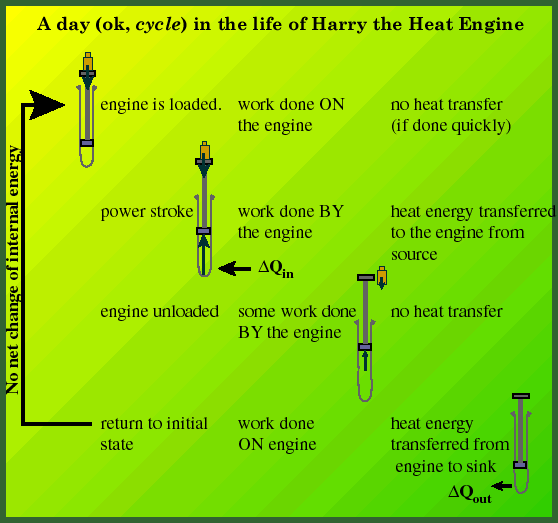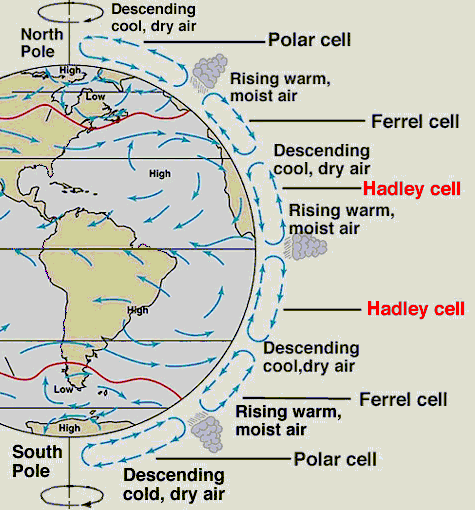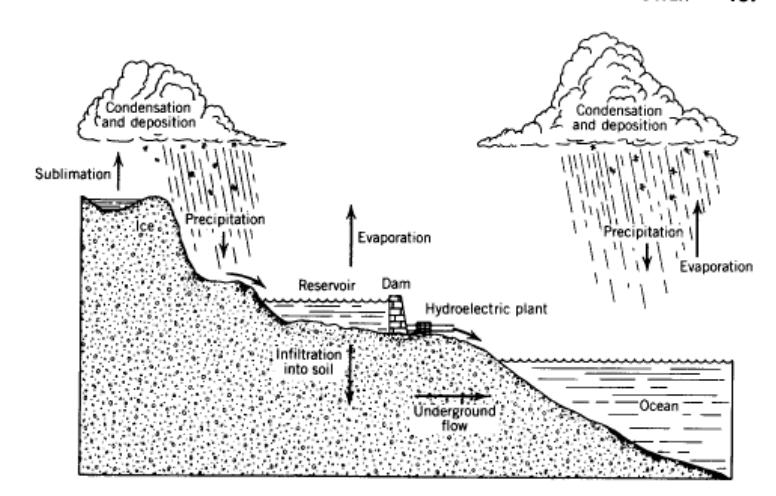![]()
![]()
Characteristics that define a heat engine?
1) "A heat engine exploits a temperature difference......"
- heat reservoir, called a heat source
- cold reservoir, more properly called a heat sink
2) "..... to do work."
- something (or things) to perform work on
3) Human-devised and naturally-occuring heat engines function cyclically.

4) Energy is conserved within the entire closed system-- heat source, engine and heat sink.
5) Some heat energy must ALWAYS be transferred to the heat sink. The engine can NOT be 100% efficient.
The function of a heat engine is analogous to the conversion of the gravitational potential energy of water stored behind a hydroelectric dam into electrical energy. In order to "generate" hydroelectricity we need an upper reservoir (behind the dam) and a lower reservoir, which may simply be a stream or river. There must be a place at lower elevation (a "heat sink") where the water can go in order to extract work (in the form of electrical energy) from the upper reservoir. Just as one can't imagine generating electricity within the reservoir of water behind a dam, work can not be extracted from a heat engine without a second reservoir at a lower temperature.
We define the efficiency of a heat engine as the ratio of the work done by the engine to the heat energy transferred from the heat source:
The efficiency of a perfect engine is given by:

Note that the efficiency of a perfect heat engine, following a Carnot cycle, is always less than 100%. Real heat engines involve losses to friction, among other things. When energy is lost to friction, it is irrecoverable. Thus the real heat engine is less efficient that the Carnot cycle engine.

The average automobile (heat) engine operates at a temperature of about 3300K, exhausting its spent fuel at 1400K. Its Carnot effiency is then:
Because the exhaust gases of an automobile are very hot relative to outdoors, more heat energy is lost in this process that what is accounted for above. That, combined with friction losses, reduces the efficiency of an automobile engine to about 25%.
![]()
 |
Weather is a short-term, local phenomenon in the atmosphere, occurring over a short time span. The weather report for today might call for rain for western Oregon while in July it might predict sunny skies and higher temperatures. |  |
Weather can change rapidly from day to day or place to place. We can characterize the weather for a certain locale by its average over many years. For example, we might keep track of temperature and precipitation for the month of February and average them over 50 years of Februarys. The resulting average values of temperature and precipitation would typify the climate of Eugene for February. The question is whether weather will suffice and whither weather is important.
We learned earlier that electromagnetic (EM) radiation serves to transfer energy across empty space and that this transfer is driven by a temperature difference. Via this mechanism the Earth (cooler body) absorbs solar radiation from the Sun (hotter body). That alone is not a sufficient condition for causing wind and weather. The solar radiation is also unequally distributed between the Earth's equator and poles:
This creates a disequilibrium between solar heating near the equator and near the poles. As a consequence, there is a temperature differential corresponding to changes in latitude which is "exploited" by climate systems (prevailing winds, etc.) to do work on the atmosphere (winds) and oceans (persistent ocean currents).
(Image sources: http://ess.geology.ufl.edu/ess/Notes/AtmosphericCirculation/atmosphere.html)

Because nature abhors concentrations of energy, Hadley cells (generically referring to Polar, Ferrel and Hadley cells) comprising persistent wind circulation patterns are set up to provide for heat transfer away from equatorial regions. This effect persists all the way to the polar regions.
Near the equator warm air laden with water vapor rises through the atmosphere (ascends) at fairly slow rates (a few cm/hour). As the air rises it cools, as it cools it loses the capacity to carry water vapor. How does the internal energy of the system {air + water vapor} change? Vapor condenses into clouds, releasing energy to the system (the latent heat of evaporation in reverse).
Because air is, in general, convecting near the equator under the rising branch of the Hadely cell, convective storms form easily there. Near +/-30 degrees latitude the subsiding branches of Hadley cells return cool, dry air to the Earth's surface. Convective storms are suppressed at these latitudes and as the cool air descends it warms. Cloud formation at these latitudes is also suppressed-- the cool, dry air warms as it descends and condensation is inhibited.
This is why most of the world's deserts and dry areas (e.g., Mojave, Sahara, Argentine Pampas, etc.) are found near +/-30 degrees latitude.
The Earth's rotation causes a deflection of the winds comprising Hadley cells, setting up persistent wind patterns, for example the trade winds and the furious forties.
(Some of this information was derived from the excellent web page "Why are deserts dry?", Milich, L., 1997. http://ag.arizona.edu/~lmilich/dry.html.)
The Hadley cells set up by the uneven, latitudinally-dependant influx of solar radiation is really just a grand conspiracy by the Earth to distribute energy evenly across its surface. Many cyclical processes identified in nature serve the same purpose. Just as nature abhors a vacuum, so does it dislike concentrated energy.
 Again? Been there, done that.
Again? Been there, done that.
Let's think about Hadley cells and climate systems in terms of our description of a heat engine.
1) The Hadley heat engine exploits a latitudinally-variable temperature difference to do work.
2) It does work on water vapor from the oceans. Once the water has evaporated, the heat input goes towards lifting water vapor higher into the atmosphere. This is how clouds form. Cloud formation and transport serves to distribute water across continents via the hydrological cycle (more on that in a minute).
3) The Hadley heat engine is cyclical in nature.
4) Energy is conserved in the entire, closed system, which includes the oceans and the atmosphere.
5) Inefficiencies result in a certain amount of heat energy being transferred to the heat sink-- the atmosphere and the oceans further away from the equator.
In fact, the "work" performed by our Hadley cell heat engine goes towards cloud formation and the start of the hydrological cycle. The "heat energy transferred to the heat sink" results in heat energy transfer away from equatorial r
Persistent ocean currents also serve to transfer heat energy away from the equator, and these currents have a profound impact on climate:
{graphic courtesy of: http://www.gcrio.org/gwcc/booklet1.html}
Even though it sometimes seems like the atmosphere tries harder, the oceans are more successful at transferring heat energy away from equatorial latitudes (remember our example about the specific heat of water vs. air and their differences in volume for a given mass).
Owing to low freshwater influx (substantial dams on the Nile, etc.) and high levels of solar insolation/evaporation, water in the Mediterranean Sea is saltier than that of the oceans in general. After leaving the Mediterranean this water exits via Gibraltar and sinks during its northward journey into the Atlantic, displacing deep, colder water. Additional warm saline water in the North Atlantic is brought up by the Gulf stream. This water is cooled by air from Canada. As it is cooled, more evaporation occurs, increasing the salinity of the water. Eventually it, too, sinks... in fact a volume of water over 20 times the water in all the world's rivers sinks in an area south of Iceland (from Energy, 1995, G. Aubrecht).
This massive downwelling of water in the North Atlantic Deep helps to drive a global system of cold and warm ocean currents, as depicted above. Cold North Atlantic Deep water finds its way south along the eastern edge of the Americas, and mixes with less saline Antarctic water, veering eastward. The water eventually rises in the Indian and western Pacific Oceans, where it is warmed, increases its salinity and, finally, finds its way back into the Atlantic, joining Mediterranean water off of Gibraltar. This ocean conveyor makes a 5 to 8 degree Celsius difference in the temperature of northern Europe. It is driven both by insolation differences and enhanced salinity of ocean water at near-equatorial latitudes. For a provocative article which suggests that a dam be constructed across the Strait of Gibraltar to forestall the next Glaciation cycle, see Johnson, R.G., 1997, "Climate Control Requires a Dam at the Strait of Gibraltar," Eos Transactions of the American Geophysical Union, V78, N27.
Oddly enough, there was an interesting article in the Register Guard yesterday entitled "Scientists forsee shift in Oregon climate." The article outlines (poorly, I might add) a study by the University of Washington Climate Impacts Group which predicts substantial and detrimental changes in Oregon's climate during the next 50 years. We'll discuss this briefly in class today.
If you would like to earn some extra credit, then visit this web site, read the 12-page summary of the report and, in 2 pages or less:
![]()
Thanks, Greg!
In the Pacific Northwest and elsewhere humankind exploits the hydrological cycle-- a mechanism whereby fresh water is transported to and from oceans; into and out of lakes, streams and glaciers; and back and forth from underground reservoirs-- to provide electrical energy from a hydroelectric plant.
We also rely on the hydrological cycle to:

The latent heat of evaporation describes the amount of heat energy transfer necessary to turn a given amount of liquid water into vapor form. This energy ultimately derives from the sun. The conversion of the sun's energy to evaporate ocean water is one of the primary mechanisms driving the hydrological cycle.
So hydroelectricity is just another form of "solar energy!"
![]()